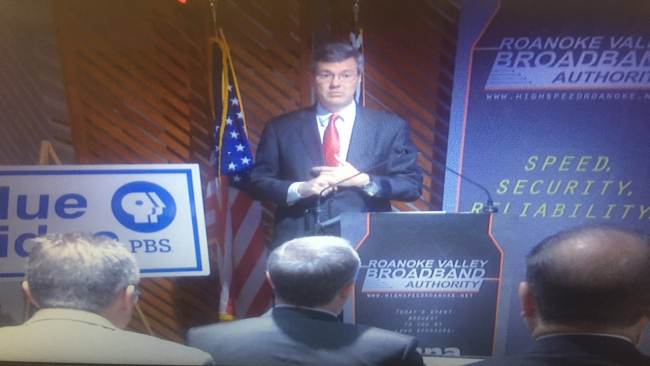
With the flick of a switch and an elaborate ribbon cutting ceremony last week the Roanoke Valley Broadband Authority turned on 47 miles of fiber optic lines capable of carrying large amounts of digital information at very high speeds – targeted primarily at business customers.
Roanoke City and Salem are fully signed on to and have funded the Broadband Authority’s development to date; Roanoke County may soon dip its toe in the water by authorizing more than 3 million dollars to install an additional 25 miles of the fiber optic pipeline along commercial corridors.
The county proposal has drawn criticism from Hollins supervisor Al Bedrosian, who believes government should not be involved in helping to supply high speed broadband if there are private carriers available. However studies have shown that the Roanoke Valley is seriously underserved when it comes to the level of broadband accessibility at speeds that cannot be offered by traditional wire cable.
“Nothing is faster than the speed of light,” said William Fralin on the day they cut the ribbon at Blue Ridge PBS, now a Broadband Authority customer. Fralin, president and CEO for Medical Facilities of America, was an early backer of the fiber optics push and helped raise the last thirty thousand dollars needed to complete a study on broadband access in the valley. It took just two weeks to raise that money for the study; another sign, said Fralin, that there indeed was great interest.
Frank Smith, hired last year as the first full time, paid president and Chief Executive Officer for the Roanoke Valley Broadband Authority, says while yes, private vendors like Cox Communications and Comcast may have fiber optic lines in some places to carry high speed data, those pipelines have not always been where the local business community wants to see them – and in some cases the pricing was not competitive.
Smith knew that firsthand when his church was quoted a monthly cost for high speed internet that he said was much too high -“ten thousand dollars a month plus installation costs . . . My jaw dropped,” he recalled. A quick look around revealed there were no other alternatives.
Smith also says private providers in the valley can actually rent space on the fiber optics pipeline to market their own high speed broadband service – using the Authority’s laser system to drive the data or their own equipment on the non-lighted “dark fiber” that constitutes about 25 percent of the fiber optics carried in each pipeline. There are five switching stations set up around the valley that drive data via a laser-driven transmission system.
“We’re looking to provide an open-access network so that other providers can ride on it, to provide service to government, business and education [clients],” said Smith. He adds that the Authority is actually partnering with existing providers on the national, regional and local levels, and to date the relationship has been positive.
Smith said the Authority’s own pricing to end user clients has not been set up to be predatory, indicating there is room at the table for private companies – who also don’t have to worry about the upfront costs for installing a fiber optics trunk line. Smith said they analyzed the pricing offered by other municipal broadband authorities when setting its guidelines. Then that pricing was published as required by state law. “Our goal here is not to put people out of business; our goal is to [be] competitive, for people to be able to choose.”
The Roanoke Valley Broadband Authority is defined as a “political subdivision” by the General Assembly, an organization that can work with both the public and private sector. Smith said they hope to hit a break-even point within six years; adding that they are working to shorten that time frame. That means contributions from local governments can go away and the Authority can become self-sustaining.
Having a high speed broadband network in place can be a major asset and a selling point for the valley, said Smith. “For us it’s more of an economic development tool to serve the government, business and education communities in the area.”
Gene Marrano


